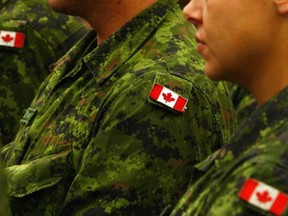The policy update will bring Canadian defence spending up to 1.76 per cent of GDP spending, which still falls short of a NATO agreement of two per cent of GDP.

Article content
Canada will buy a new fleet of early warning aircraft as well as helicopters and missiles as part of a boost by the Liberal government to the country’s defence capabilities.
The Liberal government released its long-awaited defence policy update on Monday, promising to increase the military’s annual budget from the current $30 billion to almost $50 billion by the end of the decade.
Advertisement 2
Article content
Article content
The Liberals have been under intense pressure from the U.S. and NATO to spend more on the Canadian Forces.
The Defence Policy Update rolls out new spending and commits to specific equipment purchases as well as outlining potential acquisitions in the future. It also promised better living conditions for Canadian Forces personnel.
“Through this policy, Canada will invest $8.1 billion over the next five years and $73 billion over the next 20 years in our national defence,” Defence Minister Bill Blair outlined in the policy titled Our North, Strong and Free.
The policy update will bring Canadian defence spending up to 1.76 per cent of GDP spending, which still falls short of a NATO agreement of two per cent of GDP.
Blair said the significant increase in defence spending reflects Canada’s commitment to eventually reach the two per cent mark.
While Canada is lagging in military spending on the GDP measure, it is still ranked seventh in the 32-nation NATO when it comes to actual dollars going to defence.
In the policy update, the Liberal government also announced a series of new equipment purchases. The government will buy specialized maritime sensors to improve ocean surveillance as well as build a new satellite ground station in the Arctic. It will also establish additional support facilities in the Arctic for military operations.
Advertisement 3
Article content
The Liberals have also committed to buying new long-range missiles for the Canadian Army. In addition, it will accelerate the establishment of a new artillery ammunition production capacity in the country. It will also boost the military’s strategic reserve of ammunition.
The war in Ukraine has exposed gaps in ammunition production and all NATO nations have faced shortages of munitions.
To improve the military’s ability to conduct cyber operations, the government will establish a Canadian Armed Forces Cyber Command. Also to be developed will be a joint cyber operations capability with the Ottawa-based electronic spy organization, the Communications Security Establishment.
Last month, this newspaper reported the Canadian Forces wants to expand its ability to launch cyber attacks and plans to conduct a series of related tests this year.
The government also noted in its defence policy update that it is also looking at acquiring new submarines for the Royal Canadian Navy but officials said those efforts are in initial stages. The Royal Canadian Navy had originally pushed to include in the defence policy update the purchase of up to 12 new submarines at a cost of $60 billion, but that was rejected.
Advertisement 4
Article content
The equipment initiatives come on top of already announced purchases as well as improvements to be made to support the joint U.S.-Canada North American Aerospace Defence Command.
Over the last year, the Liberal government has announced more than $30 billion in new equipment programs, ranging from fighter jets to surveillance planes, with most of that money going to U.S.-owned companies.
The defence policy update, or DPU, was announced on April 7, 2022. National Defence had already consulted with allied nations, the defence industry and defence experts who are closely aligned with the Canadian Forces and supportive of the military.
During a technical briefing on Monday, defence officials said that Blair had already briefed NATO Secretary General Jens Stoltenberg. The reception to the updated policy was very positive, they added.
U.S. officials were also briefed. U.S. Ambassador David Cohen, who has criticized Canada for its level of military spending, said last week that the American government now takes “a broader view” of NATO’s two per cent GDP spending target.
“We choose to look at Canada’s overall commitment to defence,” Cohen said during a panel discussion at the Canadian War Museum.
David Pugliese is an award-winning journalist covering Canadian Forces and military issues in Canada. To support his work, including exclusive content for subscribers only, sign up here: ottawacitizen.com/subscribe
Article content


